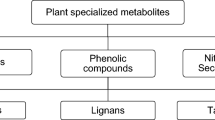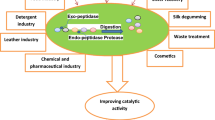Abstract
The recent progress in knowledge on biochemical properties and functions of phospholipases A2 in plants paved the way for approving the suitability of these enzymes for commercial use now. The secreted phospholipases A2, representing one type of phospholipases A2 occurring in plants, show distinct differences in substrate specificities with respect to headgroup and acyl chains of the glycerophospholipids in comparison to their counterparts from animal sources. The other type of phospholipases A2 in plants, the patatin-related phospholipases A2, is characterized by broad substrate specificity. Accordingly, the unique properties of the plant enzymes open new horizons to engineered biocatalysts with improved performance, e.g., for vegetable oil refinement by degumming and for targeted modification of phospholipids.



Similar content being viewed by others
References
Alferez F, Lluch Y, Burns JK (2008) Phospholipase A2 and postharvest peel pitting in citrus fruit. Postharvest Biol Technol 49:69–76
Balsinde J, Balboa MA (2005) Cellular regulation and proposed biological functions of group VIA calcium-independent phospholipase A2 in activated cells. Cell Signal 17:1052–1062
Bezzine S, Bollinger JG, Singer AG et al (2002) On the binding preference of human groups IIA and X phospholipases A2 for membranes with anionic phospholipids. J Biol Chem 277:48523–48534
Burke JE, Dennis EA (2009) Phospholipase A2 structure/function, mechanism and signaling. J Lipid Res 50:S237–S242
Chojnacka A, Gladkowski W, Kielbowicz G et al (2009) Enzymatic enrichment of egg-yolk phosphatidylcholine with a-linolenic acid. Biotechnol Lett 31:705–709
de Maria L, Vind J, Oxenboll KM et al (2007) Phospholipases and their industrial applications. Appl Microbiol Biotechnol 74:290–300
Dessen A, Tang J, Schmidt H et al (1999) Crystal structure of human cytosolic phospholipase A2 reveals a novel topology and catalytic mechanism. Cell 97:349–360
Dhondt S, Geoffroy P, Stelmach BA et al (2000) Soluble phospholipase A2 activity is induced before oxylipin accumulation in tobacco mosaic virus-infected tobacco leaves and is contributed by patatin-like enzymes. Plant J 23:431–440
Fujikawa R, Fujikawa Y, Iijima N et al (2005) Molecular cloning, expression, and characterization of secretory phospholipase A2 in tobacco. Lipids 40:901–908
Ghomashchi F, Yu BZ, Berg O et al (1991) Interfacial catalysis by phospholipase A2: substrate specificity in vesicles. Biochemistry 30:7318–7329
Ghosh M, Tucker DE, Burchett SA et al (2006) Properties of the Group IV phospholipase A2 family. Prog Lipid Res 45:487–510
Guo Z, Vikbjerg AF, Xu X (2005) Enzymatic modification of phospholipids for functional applications and human nutrition. Biotechnol Adv 23:203–259
Hirschberg HJ, Simons JW, Dekker N et al (2001) Cloning, expression, purification and characterization of patatin, a novel phospholipase A. Eur J Biochem 268:5037–5044
Holk A, Rietz S, Zahn M et al (2002) Molecular identification of cytosolic, patatin-related phospholipases A from Arabidopsis with potential functions in plant signal transduction. Plant Physiol 130:90–101
Iwasaki Y, Yamane T (2004) Enzymatic synthesis of structured lipids. Adv Biochem Eng Biotechnol 90:151–157
Katsir L, Chung HS, Koo AJ et al (2008) Jasmonate signaling: a conserved mechanism of hormone sensing. Curr Opin Plant Biol 11:428–435
Kienesberger PC, Oberer M, Lass A et al (2009) Mammalian patatin domain containing proteins: a family with diverse lipolytic activities involved in multiple biological functions. J Lipid Res 50:S63–S68
Kim JY, Chung YS, Ok SH et al (1999) Characterization of the full-length sequences of phospholipase A2 induced during flower development. Biochim Biophys Acta 1489:389–392
Lee HY, Bahn SC, Kang YM et al (2003) Secretory low molecular weight phospholipase A2 plays important roles in cell elongation and shoot gravitropism in Arabidopsis. Plant Cell 15:1990–2002
Lee HY, Bahn SC, Shin JS et al (2005) Multiple forms of secretory phospholipases A2 in plants. Prog Lipid Res 44:52–67
Lubertozzi D, Keasling JD (2009) Developing Aspergillus as a host for heterologous expression. Biotechnol Adv 27:53–75
Mansfeld J, Ulbrich-Hofmann R (2007) Secretory phospholipase A2-a from Arabidopsis thaliana: functional parameters and substrate preference. Chem Phys Lipids 150:156–166
Mansfeld J, Gebauer S, Dathe K et al (2006) Secretory phospholipase A2 from Arabidopsis thaliana: insights into the three-dimensional structure and the amino acids involved in catalysis. Biochemistry 45:5687–5694
Munnik T, Testerink C (2009) Plant phospholipid signaling—‘in a nutshell’. J Lipid Res 50:S260–S265
Murakami M, Kudo I (2002) Phospholipase A2. J Biochem 131:285–292
Murakami M, Kudo I (2004) Secretory phospholipase A2. Biol Pharm Bull 27:1158–1164
Nevalainen KM, Te’o VS, Bergquist PL (2005) Heterologous protein expression in filamentous fungi. Trends Biotechnol 23:468–474
Ollis DL, Cheah E, Cygler M et al (1992) The alpha/beta hydrolase fold. Protein Eng 5:197–211
Pattus F, Slotboom AJ, de Haas GH (1979) Regulation of phospholipase A2 activity by the lipid–water interface: a monolayer approach. Biochemistry 18:2691–2697
Pikaard CS, Brusca JS, Hannapel DJ et al (1987) The two classes of genes for the major potato tuber protein, patatin, are differentially expressed in tubers and roots. Nucleic Acids Res 15:1979–1994
Rietz S, Holk A, Scherer GF (2004) Expression of the patatin-related phospholipase A gene AtPLA IIA in Arabidopsis thaliana is up-regulated by salicylic acid, wounding, ethylene, and iron and phosphate deficiency. Planta 219:743–753
Roos W, Viehweger K, Dordschbal B et al (2006) Intracellular pH signals in the induction of secondary pathways—the case of Eschscholzia californica. J Plant Physiol 163:369–381
Rydel TJ, Williams JM, Krieger E et al (2003) The crystal structure, mutagenesis, and activity studies reveal that patatin is a lipid acyl hydrolase with a Ser-Asp catalytic dyad. Biochemistry 42:6696–6708
Ryu SB, Lee HY, Hwang IW et al (2008) Transgenic plants with increased resistance to biotic and abiotic stresses and accelerated flowering time due to overexpression of a secretory phospholipase A2 (sPLA2). PCT Int Appl Patent WO 2008100112
Schaloske RH, Dennis EA (2006) The phospholipase A2 superfamily and its group numbering system. Biochim Biophys Acta 1761:1246–1259
Schwendener RA (2007) Liposomes in biology and medicine. Adv Exp Med Biol 620:117–128
Senda K, Yoshioka H, Doke N et al (1996) A cytosolic phospholipase A2 from potato tissues appears to be patatin. Plant Cell Physiol 37:347–353
Seo J, Lee HY, Choi H et al (2008) Phospholipase A2b mediates light-induced stomatal opening in Arabidopsis. J Exp Bot 59:3587–3594
Sonnewald U, Sturm A, Chrispeels NJ et al (1989) Targeting and glycosylation of patatin the major potato tuber protein in leaves of transgenic tobacco. Planta 179:171–181
Stahl U, Ek B, Stymne S (1998) Purification and characterization of a low-molecular-weight phospholipase A2 from developing seeds of elm. Plant Physiol 117:197–205
Stahl U, Lee M, Sjodahl S et al (1999) Plant low-molecular-weight phospholipase A2S (PLA2s) are structurally related to the animal secretory PLA2s and are present as a family of isoforms in rice (Oryza sativa). Plant Mol Biol 41:481–490
Wang X, Wang C, Sang Y et al (2002) Networking of phospholipases in plant signal transduction. Physiol Plant 115:331–335
Watanabe J, Ishihara K (2008) Establishing ultimate biointerfaces covered with phosphorylcholine groups. Colloids Surf B Biointerfaces 65:155–165
Zhang AL, Luo JX, Zhang TY et al (2008) Recent advances on the GAP promoter derived expression system of Pichia pastoris. Mol Biol Rep. doi:10.1007/s11033-008-9359-4
Acknowledgment
I thank Prof. Renate Ulbrich-Hofmann for critical reading of the manuscript and appreciate her continuous support throughout all of time.
Author information
Authors and Affiliations
Corresponding author
Electronic supplementary material
Below is the link to the electronic supplementary material.
Rights and permissions
About this article
Cite this article
Mansfeld, J. Plant phospholipases A2: perspectives on biotechnological applications. Biotechnol Lett 31, 1373–1380 (2009). https://doi.org/10.1007/s10529-009-0034-1
Received:
Revised:
Accepted:
Published:
Issue Date:
DOI: https://doi.org/10.1007/s10529-009-0034-1




